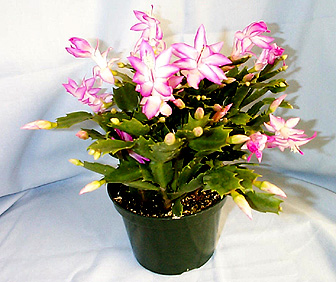 |
| Family | | | Food | | | Garden | | | House & Home | | | Money |
| Articles | | | Coloring | | | Cookbooks | | | Reviews | | | Newsletter |
 |
| Family | | | Food | | | Garden | | | House & Home | | | Money |
| Articles | | | Coloring | | | Cookbooks | | | Reviews | | | Newsletter |
Thanksgiving Cactusby Dr. Leonard Perry |
 |
Sign Up For Our | |
|
|||
|
You have probably heard of the Christmas cactus, which produces gorgeous red and pink blossoms during the holiday season. But did you know that there is also a Thanksgiving cactus, which, as you've probably guessed, comes into bloom in November? You can tell the Thanksgiving cactus (Schlumbergera truncata) apart from the Christmas cactus (Schlumbergera x Buckleyi) from the shape of its leaves. It has sharply serrated or "toothed" leaves as compared to the more rounded leaves of the Christmas cactus. You may see the Thanksgiving cactus listed as zygocactus in some books, its former Latin name. And to confuse things even more, there's also an Easter cactus (Rhipsalidopsis gaertneri) with leaves that are almost three-dimensional with a thick ridge on one side. This cactus blossoms in the early spring. Most garden centers carry holiday cactus plants although it is easy to grow them from cuttings. When planted in a decorative pot, they make a nice hostess gift, holiday table centerpiece, or present for friends and family. To propagate, snip off a branch with four or five segments or sections of leaves. Dust the cut end of the cutting with a fungicide or rooting powder to help the new plant grow roots. You can buy rooting hormone at your local garden center or nursery supply store. It is usually a good idea to place the cutting where it will get good air circulation, out of direct sun, for a week or so to allow the wound to begin healing before planting. Fill a small flower pot with potting soil, vermiculite, or damp sand. To plant, push the root end of the cutting into the potting medium about one inch deep. The medium should be kept just barely moist, not wet. To help prevent the soil from drying out, invert a plastic bag over the pot. Use straws or popsicle sticks to keep the bag from resting on the foliage. Vent frequently to keep from being too moist. For best results, place the pot in a spot that gets plenty of light but is out of direct sunlight. You should see new growth in three to four weeks. Once your plant becomes established, allow the soil to dry out during "resting periods," or in other words, when it is not producing blooms. Water only when the soil is very dry to the touch. Overwatering can kill the plant. Provide plenty of indirect light and room temperatures of 60 to 65 degrees F. Beginning in early to mid-September, these cacti will need 12 to 14 hours of total darkness along with cool nighttime temperatures in order to form buds. The easiest way to achieve this is to place the plant in a closet from 6 p.m. to 8 a.m. Or you can cover it with a large brown paper bag. If you keep the plant in a cool room (around 50 degrees F 24 hours a day) in September and October, chances are excellent that it will produce flowers, regardless of day length. Once buds start to form, apply houseplant fertilizer according to label directions to encourage lush growth and an abundance of blooms. Too high a temperature or too low a light level will cause buds to drop. Repot as needed to prevent plants from becoming rootbound, which will inhibit bloom. However, as these plants can grow quite large over time, and will live for years with proper care, you may want to keep them fairly pot bound to keep them small. Dr. Leonard Perry is an Extension Professor at the University of Vermont.
send feedback to: feedback@sherriallen.com. |
|||


|
home
|
family
|
food
|
garden
|
house & home
|
money
|
article archive
|
reviews
|
coloring pages
|
contact us
|
terms and conditions . privacy policy |
copyright © 2003 - 2006 by Sherri Allen all rights reserved |